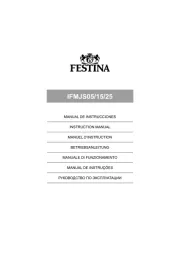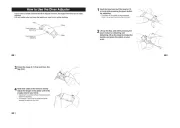Girard-Perregaux Bridges 93505-53-232-BA6F Handleiding
Girard-Perregaux
Horloge
Bridges 93505-53-232-BA6F
Bekijk gratis de handleiding van Girard-Perregaux Bridges 93505-53-232-BA6F (12 pagina’s), behorend tot de categorie Horloge. Deze gids werd als nuttig beoordeeld door 23 mensen en kreeg gemiddeld 4.3 sterren uit 12 reviews. Heb je een vraag over Girard-Perregaux Bridges 93505-53-232-BA6F of wil je andere gebruikers van dit product iets vragen? Stel een vraag
Pagina 1/12

INSTRUCTION FOR USE
CONSTANT ESCAPEMENT L.M.


THE HIGH-TECH REVOLUTION IN MOTION
This true technical revolution stunned connoisseurs when prototypes of the innovative mechanism
were first presented. Based on the ground-breaking prototypes presented in 2008, it has taken
five years of research and development to bring this signature movement to fruition. Watchmaking
history will be forever marked by this significant achievement in chronometry, paired with the superb
balance and singularity of this movement.
The name, in addition to being a nod to one of the Maison’s historical figures, Constant Girard-Perre-
gaux, also refers to a holy grail in mechanical watchmaking that has perplexed watchmakers since the
dawn of time: the constant force. Keeping true to its innovative vision, the brand decided to try using
a quite novel approach to achieve it. The initials “L.M.” stand for Luigi Macaluso, who decided to trust
and promote this movement, introduced as a working prototype in 2008 and launched now as part
of the Girard-Perregaux collection.
The concept presented on that occasion in the form of a functional mechanism was breathtaking,
promising and poetic: the design was lightweight and graceful. However, the goal was far from being
the result of art for art’s sake, this was a new and convincing answer to the age-old preoccupation in
watchmaking: the precision and regularity of a mechanical watch.
To get an idea of what is at stake and truly understand the importance of this innovation, it is worth
recalling a few basic notions. The heart of a mechanical watch is ruled by the regulating organ, which
manages the flow rate of the energy received from the barrel to drive the gear train and the rotation
speed of the hands. The classic image is that of a faucet managing the flow of water.
The main factor is not so much the speed of the beats of this heart, the chosen frequency, but their
regularity. The dance can be three in a bar or four in a bar, or even a thousand; but the essential thing
is that it keeps the beat over time.
All sorts of systems had been dreamed up before the famous Swiss lever escapement was presented in
wristwatches, and became more or less standard. Yet it suffers from one drawback: it can only give back
the energy it receives from the barrel, which diminishes with time. This energy, which defines its timekeeping
accuracy, is too fast to start with, and finishes like a machine running out of steam. A curve, the curse and
the bane of watchmakers, illustrates the phenomenon: the curve of the amplitude, or angular displacement
of a sprung balance wheel or a pendulum, which lessens towards the end of the run.
The inspiration came from an experiment, which anyone can repeat by holding a business card vertically
between thumb and forefinger, bending it to form a C or an open round bracket. If you then apply pressure
from the side you will feel resistance until the moment when the card snaps to the other side to mirror its for-
mer shape, and close the round bracket. The phenomenon of instability is known as buckling, which is the
passage from a state of compression to one of bending. Spring specialists thus speak of buckled blades.
Product specificaties
| Merk: | Girard-Perregaux |
| Categorie: | Horloge |
| Model: | Bridges 93505-53-232-BA6F |
Heb je hulp nodig?
Als je hulp nodig hebt met Girard-Perregaux Bridges 93505-53-232-BA6F stel dan hieronder een vraag en andere gebruikers zullen je antwoorden
Handleiding Horloge Girard-Perregaux

27 Augustus 2023

27 Augustus 2023

27 Augustus 2023

27 Augustus 2023

27 Augustus 2023

27 Augustus 2023

27 Augustus 2023

27 Augustus 2023

27 Augustus 2023

27 Augustus 2023
Handleiding Horloge
- Casio
- Kogan
- Fitbit
- Tauchmeister
- Fila
- Luminox
- Lambretta
- Radley London
- ETT
- Tommy Hilfiger
- Clas Ohlson
- Stuhrling
- AMS
- Polar
- Pyle
Nieuwste handleidingen voor Horloge

5 Juli 2025

5 Juli 2025

4 Juli 2025

4 Juli 2025

4 Juli 2025

4 Juli 2025

4 Juli 2025

2 Juli 2025

1 Juli 2025

21 Juni 2025